When I received a tip that Christie’s would be including a group of paintings from Greta Garbo’s collection in the May 2017 Impressionist and Modern auction, the news took me back to an exciting afternoon 27 years ago when I was invited to her apartment to see her extraordinarily bold collection as she lived with it, before many of the paintings and Louis XVI furnishings were removed to be catalogued and eventually sold.
Gretta Garbo (1905-1990) was a deft and intrepid collector with a fearless taste for color. Each of the three paintings in the coming Christie’s auction lays claim to a significance in the careers of the artists that makes them at least as noteworthy as their celebrity provenance.
Robert Delaunay’s La femme à l’ombrelle ou La Parisienne (estimate $3.5-6 million) dates from the annus mirabilis of 1913, when Delaunay was breaking through to a new level of abstraction. Three years later, Alexej von Jawlensky painted Das blasse Mädchen mit Grauen Zopfen (estimate $1-1.5 million), one in a group of pivotal works from the artist’s years in exile that Garbo owned. Chaïm Soutine’s Femme à la poupée (estimate: $3.5-4.5 million) was made in 1923-24 during his productive time in Cagnes-sur-Mer, when the artist was bolstered by the support of the American collector Dr. Albert Barnes, who became a significant guiding figure in Garbo’s own collecting.
My memory of seeing the full collection intact in Garbo’s 52nd Street apartment overlooking the East River is still dominated by the unforgettable blast of color that came into view as I turned the corner of the L-shaped drawing room and saw what was simply referred to as “the wall.” To refresh my recollection, her family graciously offered a photograph, for exclusive publication by Hamptons Art Hub, of the array of brilliant paintings that danced in a crescendo of brilliant reds, greens, golds and blues toward the blast of light from the huge windows on the river.
.
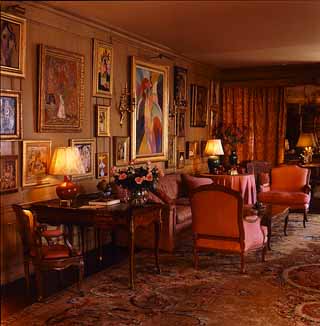
Greta Garbo's art collection installed on "the wall" in her New York City apartment on East 52nd Street. The photo has never been published and is exclusive to Hamptons Art Hub. Courtesy of Gray Horan. Reproduction is strictly forbidden.
.
Certain walls from museum shows, galleries, country houses and collections remain in the memory with or without the aid of photographs or notes. I cherish indelible memories of the climactic walls in retrospectives of Van Gogh, Mondrian (both in Washington at the National Gallery and in its later MoMA iteration), Picasso, and Robert Ryman, among a select few, and the Frick Collection long gallery with the Vermeers, Turner and Rembrandt. Garbo’s great wall of color has the same vivid grasp on my memory.
At the time, I was just completing 12 years of inter-disciplinary research on color theory for a book, and the wall was heaven-sent for my research. It was dominated by a group of paintings by Jawlensky, including the one in the Christie’s sale, and particularly by the large Delaunay that I anticipate will be a highlight of the spring auction season in New York.
In addition to its celebrity provenance, there are a number of factors that make the Delaunay particularly impressive. It was painted, according to the Christie’s catalogue, a matter of weeks before the art historically significant Premier Disque, a landmark in painting’s progress toward abstraction. In La femme à l’ombrelle the boldly evocative and decidedly non-mimetic expanses of loud red, lemon yellow and bright green are barely connected to the umbrella and dress sported by the artist’s Russian-born wife, Sonia Terk Delaunay, as she walks across the lawn of the Jardin du Luxembourg.
.
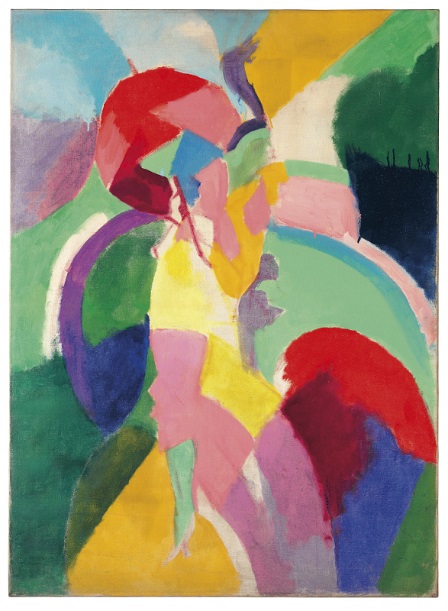
"Femme à l’ombrelle ou La Parisienne," 1913, by Robert Delaunay (1885-1941). Oil on canvas, 48⅜ x 35½ in (122.8 x 90.2 cm). Courtesy Christie's.
.
Robert and Sonia Delaunay were pivotal figures in the transition from Impressionism to Modernism, challenging the silvered palette of the Cubists with prismatic color that spawned an independent contemporary group of American painters, such as Stanton MacDonald-Wright and Morgan Russell. As Garbo’s Delaunay demonstrates, they gave color priority over line. The work is a great example of the transparency that gives a sense of depth, a tonal body built from layers of color chosen according to optical laws of mixture.
Delaunay often presents a full, high-toned spectrum in the work, its schematic stiffness softened by the sfumato of his edges. In the portrait, which reminds me as well of Claude Monet’s windblown image of his wife Camille under a parasol on a hilltop, the atmospheric effects are a source of pure energy. The avant-garde poet Blaise Cendrars, a close friend of the Delaunays—who collaborated on an amazing illuminated edition of one of his long poems—captures the effect in an essay titled “Contrasts” from the same year: “The windows of my poetry are wide open onto the boulevards … Everything is splashes of color. And the women’s hats going by are like comets in the burning evening.”
The Delaunay painting was a major moment on “the wall” and it was touching to learn from Garbo’s grandniece Gray Horan that it was not only her beloved great-aunt’s personal favorite, but that of her mother as well.
Garbo, as film buffs know, retired from making movies in 1941, and took up art collecting seriously in the 1940s. One of the secrets to understanding her penchant for such strong selections was revealed to me during my first visit in 1990, when I casually inquired about a delightful painting in the hall that reminded me of the work of the synthetic Cubist Andre Lhote, a terrific example of whose work was also in the apartment. I learned that the small painting I had asked about was by Sven Gustafson, Garbo’s brother and a protégé of Lhote’s in his Paris atelier.
In addition to Dr. Barnes and the expert eye of her brother, she relied on friends such as Alfred Barr, the curatorial mind behind the formation of MoMA’s permanent collection, as well as dealers and rival collectors. One day in 1942 at the Jacques Seligmann gallery in New York, she was zeroing in on a Renoir portrait of his nephew that the dealer regretfully explained had just been committed to another buyer. Suddenly from a back room, Dr. Barnes emerged and insisted that she take the Renoir as her own. “Young lady, you take it instead. You won’t regret this purchase,” she recalled him saying.
The influence of Barnes is probably behind her choice of the lusciously painted Soutine, Femme à la poupée, 1923-24, in the Christie’s auction, with its twisting hands so similar to works by Vincent Van Gogh that feature children. This piece bears a close resemblance to another of Garbo’s paintings, a seated child painted by Louis Valtat that Garbo had bought in Paris in 1969.
.
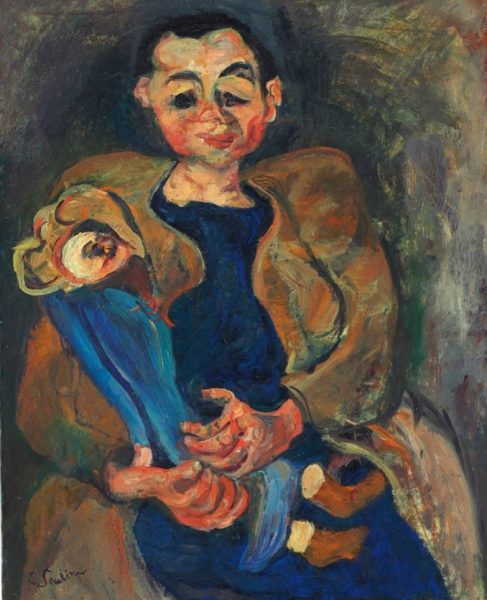
"Femme à la poupée," 1923-24, by Chaim Soutine (1893-1943). Oil on canvas, 31⅞ x 25⅝ in (80.8 x 65.1 cm). © 2017 Artists Rights Society (ARS), New York. Courtesy Christie's.
.
The terrific Jawlensky painting in the auction is one of an important group that Garbo acquired in California when she met the Jawlensky expert Galka Scheyer at a salon hosted by Salka Viertel, her co-star in the German language version of Anna Christie. As Angelica Jawlensky, the artist’s descendant, attests: “Together, the Garbo paintings represent a pivotal moment in Jawlensky’s life, a period when, after an inner crisis, he began to create something new, full of energy, hope and harmony.” As with the Delaunay, which was a bridge to the German group of color pioneers known as the Blaue Reiter, the Jawlensky works played a huge part in the international movement toward abstraction in painting.
.
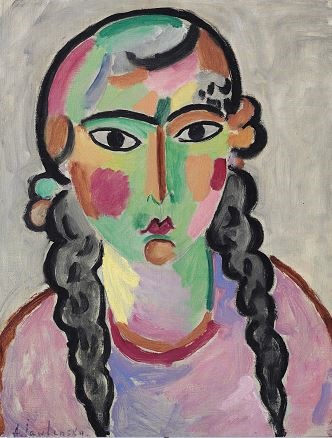
"Das blasse Mädchen mit grauen Zopfen," circa 1916, by Alexej von Jawlensky (1864-1941). Oil over pencil on linen-finish paper laid down on masonite, 25 x 19½ in (63.5 x 49.5 cm). Courtesy Christie's.
.
The timing of the auction could not be better for the Delaunay and Jawlensky, as both are taking star turns in museum exhibitions in New York this season. A major painting by Delaunay dominates a room in the Cooper-Hewitt’s “Jazz Age” exhibition, and the Neue Galerie is featuring a Jawlensky retrospective.
In an interview with Garbo’s grandniece, Gray Horan, I learned that the bold eye that led her great-aunt to acquire “safe” works such as two Renoir paintings and Old Master drawings also had an unflinching affinity for Modernism, as exemplified by the Delaunay. “What is so spectacular about the Delaunay are the blur and the almost Abstract Expressionist drip,” she said. “While it responds to Cubism and those planar elements, it has this joyful blending of rain and sunshine.”
Horan visited Garbo at the apartment regularly, discussing the works with her (they enjoyed the game of wondering what the portraits might have to say to one another). Horan’s understanding of her great-aunt’s aesthetic is formidable. As she noted, “Color was always the essential component … Nothing was black and white.” In a marvelous essay published in August 1990 on the collection, Horan wrote: “Each piece, each painting had an interest all its own, yet nothing arrested your vision. There was no centerpiece or focal point. Your perception was kept fluid, moved along by the color and the array.”
As we talked about the three portraits and what they meant to Garbo, Horan added a further reflection: “Garbo responded emotionally to beauty, and color was the way she gauged beauty.” From the upholstery and drapes to the Charles X Savonnerie carpet, the whole apartment was brimming with salmon pinks, bright greens and glowing gold, the bookcases filled with classics (in French and German; she loved the poetry of Heine) bound in red and green morocco. To the rest of the world, Garbo may have existed in black and white, but surrounded by her art and family she lived in vibrant color.
.
.
________________________
BASIC FACTS: Click here to read more about Greta Garbo as an art collector. Christie's Impressionist and Modern Art Evening Sale takes place on May 15, 2017 at 7 p.m. at Rockefeller Center in New York. Viewing takes place from May 6 to 15, 2017. Click here for details.
________________________
Copyright 2017 Hamptons Art Hub LLC. All rights reserved.

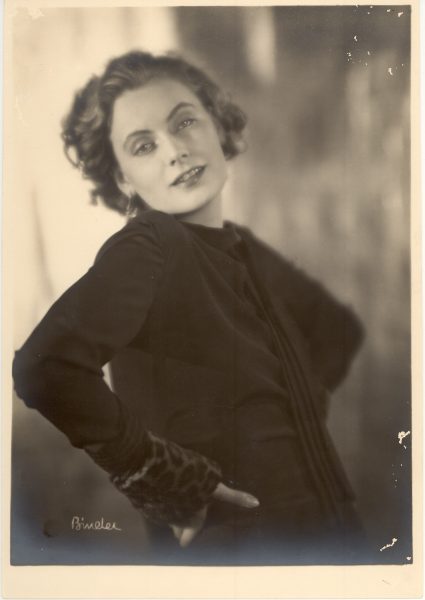
just found out that the viewing of the Garbo paintings at Christie’s will begin this Saturday, May 6